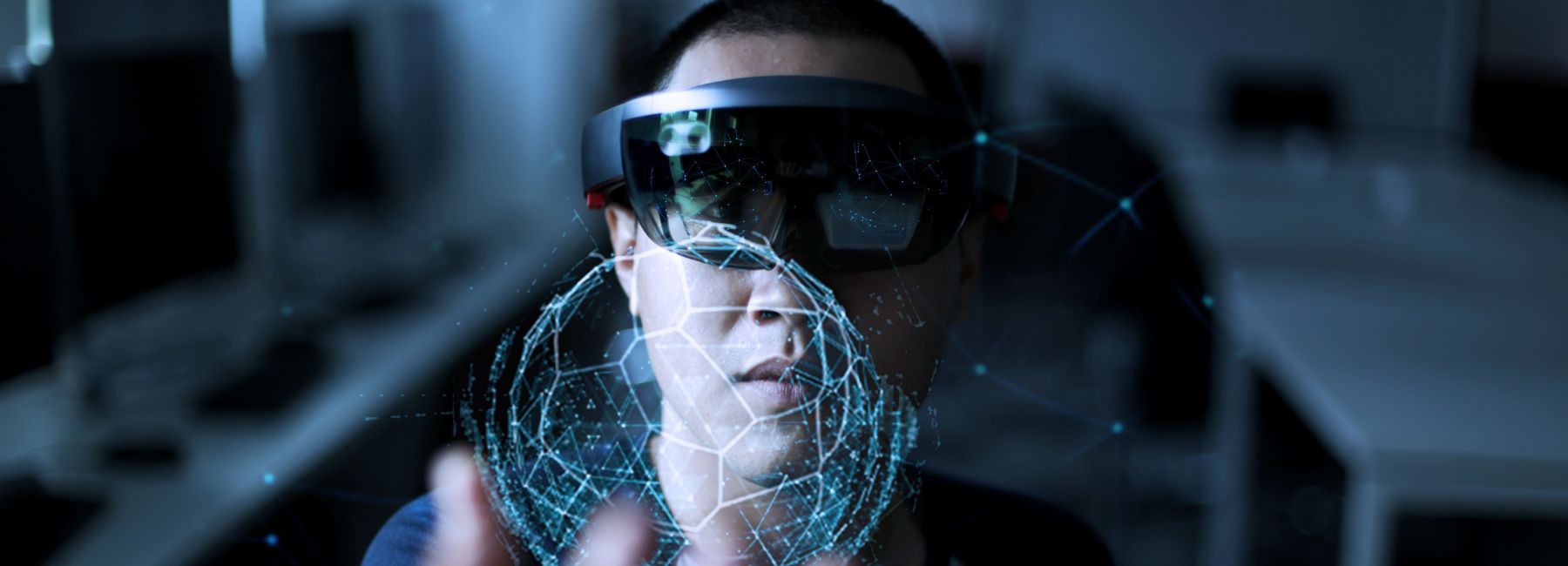The power of mixed reality (MR) lies in its ability to blend the physical world with the digital world. Digital data augments the work going on in a real-life environment — a training center, a factory floor or even an operating room. People who have to learn complicated — perhaps hazardous — processes or perform complex procedures are among those who can benefit greatly from using MR technology. This paper shows you how you can bring value to your organization with MR.
There is often confusion about the differences among MR, augmented reality (AR) and virtual reality (VR). The VR experience puts the user completely in a 100% digital, artificial world, while the AR experience overlays objects onto a user’s real-world view, just like a Heads Up Display (HUD) inside a fighter pilot’s goggles.
MR combines aspects of both, allowing users to treat their physical reality like a virtual one by conjuring 3D holograms and interacting with them as if they were real objects. For example, using MR, a doctor preparing for surgery could pull up a holographic copy of a patient’s heart, and handle and study it as if it were the real thing.
MR industry use cases multiply
The three technologies together are building a dynamic market presence. The global MR, AR and VR market size is projected to reach $125 billion by 2027, according to ResearchandMarkets.
Spurring growth are factors including a growing number of VR headsets and improvements in connectivity, according to a Frost & Sullivan analysis. Microsoft’s HoloLens 2, Magic Leap 2 and Meta’s latest device, the Quest Pro, are among headset providers in the market today. Apple reportedly may have a device available this year, and Google possibly by 2024. Of course, the continuing rollout of high-bandwidth, ultra-low latency 5G coverage will play a significant role.
Businesses across the spectrum will leverage the technology to make their mark in various ways. The healthcare and manufacturing industries (automotive in particular) will be among the leading sectors, but construction, education, engineering, law enforcement and retail will take advantage of the technology, too. Some people will be surprised to learn that even social welfare services organizations see applications for MR, such as hologram-assisted counseling to help previously incarcerated people avoid repeat offenses and safely re-integrate into society.
MR goes into action
As with all new technologies, some companies will be hesitant to move forward too quickly. DXC Technology collaborates with our customers to introduce them to the technology via Mixed Reality in a Day workshops, where we provide consulting and design-thinking services to identify high-value use cases with them. The outcome is a prioritized list of use cases that are candidates for an MR pilot with DXC to achieve tangible business benefits.
Early adopters are already seeing returns. For example, DXC has worked with a company to streamline maintenance for complex machines by using MR to create a 3D instruction model using pictures and diagrams that addressed the most common issues. The added context of 3D objects lets people see a physical system in full clarity, doing away with any potential misinterpretation of real-world physical systems or spaces.
We also helped a manufacturing company harness the opportunity to improve its training. We created and implemented holographic training to help teams learn to set up and maintain precision machinery, reducing complexity by translating everything into a 3D environment accessible via HoloLens headsets. This change in approach helps assure operational continuity for the business.
Working exclusively with holograms can be of immense value when it comes to maintaining the health and safety of employees that must learn potentially hazardous procedures.
Working exclusively with holograms can be of immense value when it comes to maintaining the health and safety of employees that must learn potentially hazardous procedures. One of our customers is using virtual models of instruments used to mix and prepare hazardous chemicals to rehearse the process without risk. Employees can work in a controlled environment where they receive clear and immediate feedback for any mistakes they make, and avoid bodily harm when they make them.
Building a spatially-aware MR application for a way-finding project, using Microsoft HoloLens and Azure Spatial Anchors, is underway for one of our customers. Way-finding projects connect spatial anchors to guide someone from point A to point B to point C and so on; developers create anchors based on the physical locations where they want to situate people to provide them the information they need to move forward to the next location. Now, people who need to progress from, say, one location in a factory to another, can don a HoloLens that projects data pointing them to the next place as a hologram. Spatial anchors can have relationships between them if, for example, a person has to perform a task at a particular location before moving to the next.
With MR, way-finding projects can open some amazing windows on the world to everyone in incredible ways. Holographic content providing context and historical information can be anchored to paintings in museums, statues in parks and other points of interest, enhancing people’s tours of famous objects and places. MR also can make it possible to see through time and space. Care to see what a Roman ruin looked like in its heyday, or explore the otherwise inaccessible, intricate components inside the hull of a ship? The opportunity is there.
One benefit that may not be immediately obvious to companies interested in MR is that it presents an opportunity to streamline business processes, adding to the value of the use case.
MR drives process efficiency
One benefit that may not be immediately obvious to companies interested in MR is that it presents an opportunity to streamline business processes, adding to the value of the use case.
For example, when it comes to creating MR training solutions, it’s not simply a matter of taking what’s in the existing corporate instruction material and pulling that together for display on a HoloLens. DXC has worked closely with customers’ subject matter experts to understand business processes for training employees; from there, we determine the most conducive and orderly approach that's suited to holographic treatment to accomplishing the job. We employ design thinking to determine how to make the experience work best for users and most efficiently for the company. Translating experiences into holographic training can actually make the business process better, increasing productivity, delivering a better quality of work and leading to cost savings. Moving to a new way of working — both on the technology and process side — is crucial to getting value out of the use case again and again.
Think of it this way: Taking an MR approach to training is the difference between relying on a 100-page long manual with text and photos to guide you through assembling a device vs. looking at the real-world device and letting holograms show you step by step how to do it more efficiently.
Additional value can come from deploying lower-ranking staff members to take on tasks usually reserved for more experienced individuals. Depending on the issue, it may be possible for a business to leverage junior engineers rather than more expensive senior engineers, saving costs and ensuring that those experts’ time is allocated to higher-priority issues. With Dynamics 365 Remote Assist, the junior engineer can just put on a headset and call in via Microsoft Teams to the senior engineer who is able to see what their colleague is seeing through her own MR headset.
There also are potential savings in travel costs. For instance, that senior engineer who’s called on may be located in another state. Now, she no longer needs to make the trek to another facility, and the company avoids the expenses. Fewer trips also can support many companies’ sustainability goals as they relate to reducing carbon emissions for business travel.
Controlling the MR environment
An important part of preparing for the move into MR is ensuring that the organization has the appropriate controls in place to manage and secure the new device types and applications.
With the introduction of new endpoints into the corporate environment, having smooth management capabilities typically is high on business’ lists. The good news is that MR devices can be managed just like PCs, laptops and smart phones. In DXC’s case, for example, we enable this through our Modern Workplace services; unified endpoint management and security is included in our Modern Device Management solutions. Additionally, our augmented workplace capabilities enable second- and third-level MR support globally, integrated with a client’s existing service desk.
The ability for IT services vendors to handle scale and complexity is going to be critical for companies as their MR deployments expand. Today, most vendors providing MR services are smaller, more specialized agencies who will struggle with large-scale production deployments.
In contrast, DXC is able to provide a true end-to-end, scalable and global MR service for our customers. We are a HoloLens distributor managed partner, providing global roll-out of devices, management, support and systems integration for the technology. We also are a Microsoft Mixed Reality Gold Partner; our MR practice is built around Microsoft technology including the HoloLens, Dynamics 365 Remote Assist and Dynamics 365 Guides. Our MR deployments run in the Microsoft cloud, with integrated security monitoring and policy management.
MR promises considerable returns
While it’s early in the MR game, companies already are realizing significant returns on their investments. A Forrester Total Economic Impact study of mixed reality using Microsoft HoloLens 2 found that a risk-adjusted financial analysis for a composite organization shows a three-year return on investment of 177%, a net present value (NPV) of $7.6 million, and a payback period of 13 months with $11.9 million in total benefits versus $4.3 million in total costs.
More investments are on the horizon as companies come to more fully appreciate the technology. In many cases, it will be critical for them to partner with experts who understand that getting the most out of MR goes beyond just implementing the technology to applying it to create actual value.
Learn more about DXC Modern Workplace.
To learn more about how DXC is helping customers on their MR journeys, contact us about our Mixed Reality in a Day workshops, MR pilots using Dynamics Remote Assist and/or Guides, custom MR apps and MR managed services.

